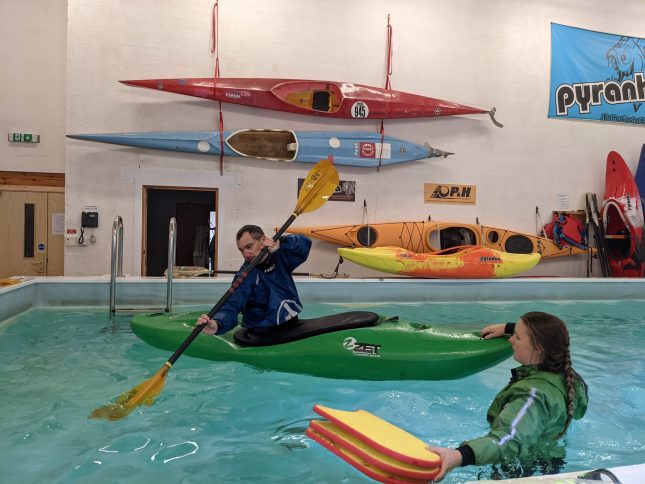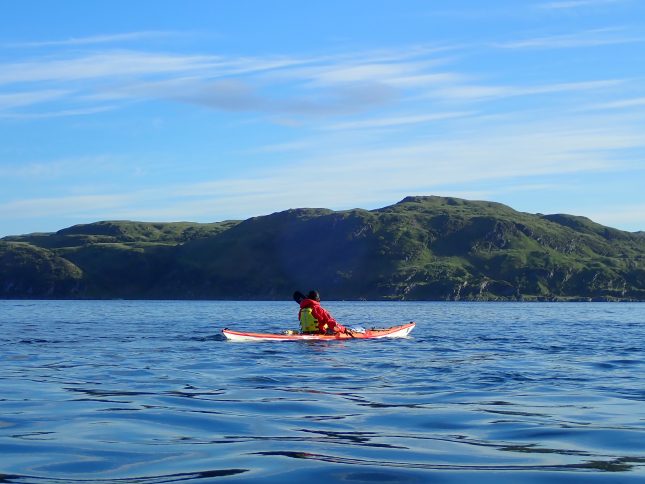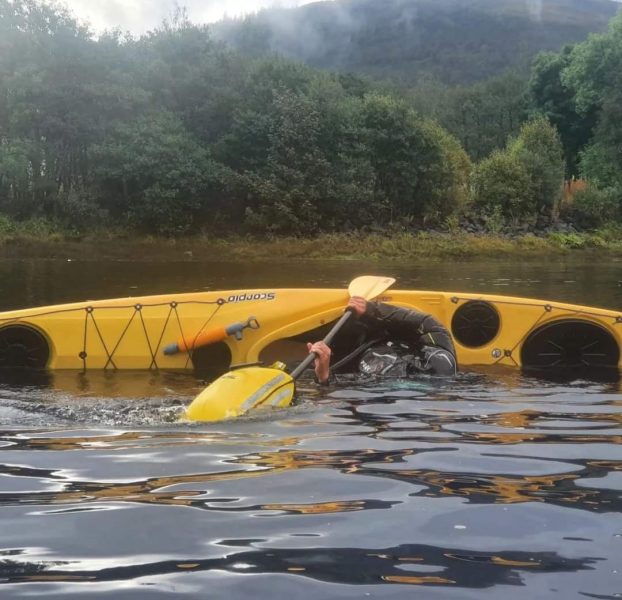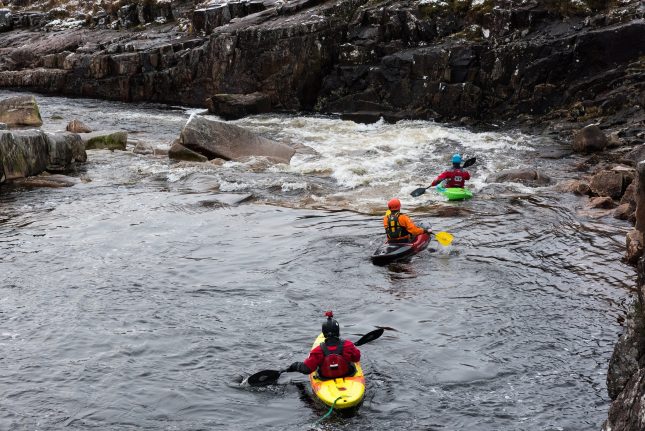Learning to Roll a Kayak: The Ups & Downs
To coincide with the launch of our new 5 day Sea and White Water Kayak Roll Builder courses, Senior Paddlesports Instructor Matt Haydock looks at the journey of learning to roll a kayak.
Learning to roll a kayak is so often the first thing many paddlers can get properly stuck on. And no wonder – it is a complex skill which requires multi-tasking, which is something which everyone’s brains and bodies find difficult. Boat, body and blade must work in harmony, producing specific movements, making specific shapes at specific times – all under water, whilst keeping a calm head. When you put it that way, of course it is not easy!
So, I thought I would share some thoughts on what the cornerstones are for developing a good “bombproof” roll, and some top tips on how you can shape your learning journey, and ideally accelerate it!
I am sure we all know those annoying people that hop in a boat, give it a bash with just a woolly description of what to do, or with one demonstration, and roll up first time! Yet, for others, it’s a long journey which can last months, even years. For some, it can also be a skill you used to be able to do, but then loose down the line. Commonly there is a stage where you can then roll in the swimming pool, but then struggle to do the same movement outdoors. You might also see your friends master it before you do, even though they’ve been to the same number of sessions as you have. So, why does this happen?!
.

.
It’s all about you and your body
Well, bold statement number 1: The overwhelming reason why some people pick it up quickly, or develop a bombproof roll anywhere and everywhere, is down to physiology – i.e. a person’s body. Flexibility, core strength, and how easy we find it to do twisty and rotational movements, with core strength added to them, are the absolute key determining factors in how this learning journey will go.
Bold statement number 2: Younger, fitter people are likely to find it easier to learn to roll (with the added bonus they tire less quickly) and thinner, more flexible people who can twist and rotate their body with some added strength, will also learn to roll quicker.
But don’t panic – that doesn’t mean you have to pay for an expensive gym membership and build yourself a time machine to go back to your 20s! All it means, is that your learning journey will be accelerated, and you’ll be able to stack the deck in your favour a bit more, if you try and maximise your individual ability to rotate and twist your body with some strength added. Yoga and Pilates are amazing secret weapons, as are basic strength and conditioning exercises, such as the Paddle UK At Home Paddlesports Workouts – YouTube. Anything you can incorporate into your everyday life that will improve your posture will also really pay dividends. Most things in our modern day life don’t help with this – car seats, office chairs, sofas – so try simple things like spend 20 minutes sat on the floor keeping a straight back whilst watching the tele, or use a stand up desk or sit on a gym ball whilst at work. Of course, if anything starts to not feel right or hurt, then stop and seek advice from someone who’s more of an expert than me!
Rotation and core strength are key to everything we do in a kayak – especially our ability to forwards paddle effectively away from the trippy places, and our ability to “shift through the gears”, which is key to paddling in spicier water. So maximising your individual rotation will also pay off by keeping you upright in the first place!
As well as these fundamental cornerstones of rotation and core strength, which we can keep plugging away at, there’s also plenty of other short and medium term things that we can do to help with our learning journey.
Structuring your practice time well
Fitting in time learning to roll a kayak isn’t always easy, so ensuring your practice time is constructive and focussed is key. Try and put together a plan of when you can fit in practice time, and ensure you are in the right head space and not too knackered. For instance hopping in a boat that isn’t yours for 10 minutes at the club pool session, after a long day at work. Of course, sometimes it can be a really useful intensive practice session, but other times it can feel like you’re going backwards with it. Another great example is the age old – “I’ll do a few practice rolls at the end of the trip.” Again, can pay off sometimes, but you are often tired at the end of a river trip or a long coastal journey. Perhaps flip it on it’s head – if you’ve a dry suit and it’s not too chilly a day, then do some practice rolls at the start of the trip when you’ve more energy.
Try and use the summer months wisely before the water get’s too chilly, because it will be so much harder to dunk your head in the winter months. Essentially try and stack the deck in your favour with your practice time to ensure it’s when you know you will have the motivation and the energy.
.

.
Connection is critical
If you have your own boat already, then try to practice as possible is in that boat. Many people head along to pool sessions and practice in a club boat which is miles too big for them, and wonder why they are not getting anywhere. In order that the rotational movements we discussed right the boat, we must be connected to the boat at our feet, thighs/knees, bum, backrest and hips. It’s important all of these body parts are connected to each other in just the right way; not so crammed in that we cannot use our leg muscles, but tight enough that our hips are engaged to initiate rotation on the boat. It needs to be comfortable for when we are paddling on the journey, and not giving us pins and needles after half an hour. Spending lots of time tinkering with your connection points as you practice, e.g. moving your footrest one closer/further away, adding more foam to your hip pads, raising or lowering your seat – this can be really worthwhile and might just produce that eureka moment.
Too many cooks
When you’re learning to roll, lots of people are always keen to help, which is of course very kind of them to give up their time to support you. However, we often get people on courses here at Glenmore Lodge that have been helped and coached by too many people. They phrase things differently, and even contradict each other, which of course leaves you confused. Often people will be trying to coach you a roll that works for them, in a way that they learnt it – but this might not work for you. My advice is therefore to try and stick with a coach that knows you, understands your strengths and challenges, and knows the roll you are working towards. Better still, utilise coaching with the aim that you can then be more independent with your learning and practice, and crucially, can analyse and review your own performance and practice attempts. It’s ideal to get to a stage where you are able to then just head down to your local waterway with your boat and kit, and all you need is a partner/friend holding a video camera for you, ready to turn you back up if needed. Our courses here at Glenmore Lodge aim to get you to the independent learning stage as an absolute minimum.
.

.
In and Out, Both Sides
A common learning journey can be to achieve a roll on one side in the pool first, and then when you try and take it outside, it all goes pear shaped again. Try and ensure you get plenty of practice both inside and outside, and both left and right, from the word go. Ensure you practice wearing kit, in chlorinated, salt and fresh water. Ween yourself off noseclips, goggles and masks as early as you can (unless medical issues mean you might require them), and try and incorporate practice in flat water, flowing water and wind/waves. Later on in the learning journey, freestyle and surf kayaking can really help sharpen a roll and make it dependable. Even further down the line, start adding a bit of pressure to the performance – How long can you stay under for before coming up? Can you do it without a “setup”? Can you do it in a place where you think “Oh, I’d have to be able to roll there!”? Be creative! All of this will of course rely on having a good team of paddle buddies to be around and about if needs be.
Different Flavours
It’s worth being aware that there are different types of roll. Indeed, there’s rumoured to be over 30 types of traditional Greenland rolling styles and techniques which form part of competitions, including a “Shotgun roll” and a “Walrus Pull”! More common styles include a C to C roll, a backdeck finish, a forward finishing sweep roll, a backdeck roll, and a Pawlata (or “extended paddle”) roll. All will have advantages and disadvantages, and work for different body shapes and sizes. A good coach will be able to identify what roll will work best for you, for your body and for the type of paddling you intend on doing – and indeed, this will be part of our courses here at Glenmore Lodge.
I’m Ready for my Close Up
Videoing your performance, if used smartly and at the right time in the learning process, can really help with your development and practice. Having the ability to draw on the video with lines/angles/points, the ability to slow down the video, and watch two performances side by side, are great features of some apps. It can often be a combination of things which might not be happening, but it can still help you identify common themes of where you might be going wrong. Paying particularly close attention to your body position in the video is key – where are you looking and where are your shoulders pointing through the manoeuvre, and what body position are you finishing in? You can also identify things like the blade angle, and how much the paddle dives (or ideally doesn’t dive!) throughout the manoeuvre, and the timing of when the boat starts the right in relation to your body movements. Once again, a good coach can help get you to a stage where you can review this performance yourself, so you know what you are looking out for when you watch it back.
.

.
Rolling buddies
As the saying goes: “A problem shared is a problem halved.” For some people the challenge of learning to roll on your own can be frustrating. So, a more social learning experience, celebrating each other’s successes, and sharing frustrations with one another, can often work really well. Even something like having a “Rolling Hopefuls WhatsApp group” can help you dissect stuff together. You can send each other videos of your attempts, arrange practice sessions together, or just rant about how hard it is! We often incorporate this into our Rolling courses here at Glenmore Lodge.
Learning Aids
Use of paddle floats and extended paddle (or “Pawlata”) rolls can be good stepping stones in the learning journey and help facilitate some earlier success. Paddle floats allow you to just focus on the body position (which as we said, is that fundamental cornerstone). But using it for too long and the blade will dive deep when you take it off, as it masks the important feeling of the blade tracking through the water. Steadily deflating it nice and early can be a good way forward. Extended paddle grips to create a longer lever can also be good stepping stones too, and then steadily weening yourself off it and returning your hands incrementally back to your normal grip.
Manage fatigue, frustrations and celebrate success
How long it takes to master this is anyone’s guess. Unlocking more flexibility and increasing rotation with core strength are the key determining factors in speeding up the process, but your head game will also affect how the learning journey will go. This article hasn’t even gone into things like water confidence and orientation underwater – which can be big initial barriers for some people that need overcoming first. But on top of that, not getting in too much of a grump is a really big part of it. Knowing when to stop because you’re either tired or getting annoyed is really important. Trying to find ways to enjoy the learning journey by combining it with other activities and people will help, and above all, remember to celebrate the “little wins” as you go along. It can all be easier said than done sometimes, but when reflecting, focus on what you are doing right as well as what you need to work on, and look back on the progress you’ve made since starting.
How we can help
We have both two day and our new five day options for those who are working on their kayak roll.
Our two day rolling clinics are designed for those who predominantly want focussed time in our purpose built kayak rolling pool. It can be for those who are starting from scratch and want a solid platform of fundamentals, and equally for those people who have started that learning journey, and want quality coaching on how to progress, along with clarity on how to practice purposefully. As a minimum, we always strive to get you to a stage where you can then continue practice independently and review your own performance, and have a clear idea of the movement patterns you are trying to achieve.
Our new five-day roll builder courses work on developing the same key fundamentals (but of course with more time to do it), whilst crucially looking at the comprehensive big picture, so it dovetails with all aspects of your paddling. The courses are discipline specific – with one for sea kayakers and one for white water kayakers. Whilst time in our on-site rolling pool will feature, needless to say it is not five days in the pool! Context is a big part of learning, so we spend time in the environment on loch, river and sea to ensure our practice is also structured outdoors – working on aspects like water confidence, other self and peer rescue methods, and rolling in different conditions with all the kit on. We look at how those key rotational movement patterns with core strength are replicated across the rest of our paddling skills, and how we can always be developing and strengthening them, both on the water, as well as off the water with some individualised strength and conditioning input. In summary, everything in this article will be explored in detail, inside and out!
So, there we have it. I hope these tips are helpful for your journey in learning to roll, and I wish you the very best of luck with it! Don’t forget to treat yourself with you get that first roll!